Read All Sheets Into One Sheet Excel R
In this tutorial, nosotros volition acquire how to piece of work with Excel files in R statistical programming surroundings. Information technology volition provide an overview of how to use R to load xlsx files and write spreadsheets to Excel.
In the showtime section, nosotros will go through, with examples, how to use R read an Excel file. More specifically, we are going to learn how to;
- read specific columns from a spreadsheet ,
- import multiple spreadsheets and combine them to one dataframe,
- read many Excel files,
- import Excel datasets using RStudio
Furthermore, in the last part we are going to focus on how to consign dataframes to Excel files. More specifically, nosotros are going to learn how to write;
- Excel files, rename the sheet
- to multiple sheets,
- multiple dataframes to a Excel file
How to Install R Packages
Now, before we continue with this Excel in R tutorial we are going to larn how to install the needed packages. In this post, nosotros are going to use tidyverses readxl and the xlsx package to read xlsx files to dataframes.
Note, we are mainly using xlsx, in this post, considering readxl cannot write Excel files, just import them into R.
# Install tidyverse install.packages("tidyverse") # or just readxl install.packages("readxl") # how to install xlsx install.packages("xlsx")
Code language: R ( r ) Now, Tidyverse comes with a lot of useful packages. For example, using the parcel dplyr (role of Tidyverse) you can remove duplicates in R, and rename a column in R's dataframe.
How to install RStudio
In the concluding example, we are going to read xlsx files in R using the interactive development environment RStudio. At present, RStudio is quite easy to install. In this post, we will cover two methods for installing RStudio.
Hither's two steps for installing RStudio:
- Download RStudio here
- Click on the installation file and follow the instructions
Now, there's another option to become both R statistical programming environment and the great full general-purpose language of Python. That is, to install the Anaconda Python distribution.
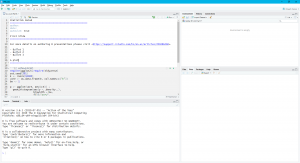
Annotation, RStudio is a bang-up Integrated Development Environment for carrying out data visualization and analysis using R. RStudio is mainly for R simply we can too utilise other programming languages ( east.1000., Python). That is, nosotros typically don't use RStudio for importing xlsx files only.
How to Read Excel Files to R Dataframes
Can R read xlsx files? In this section, we are going to observe out that the answer is, of class, "yes". We are going to acquire how to load Excel files using Tidyverse (eastward.g., readxl).
More specifically, in this section, we are going to learn how to read Excel files and spreadsheets to dataframes in R. In the read Excel examples we will read xlsx files from both the difficult drive and URLs.
How to Import an Excel file in R using read_excel
Outset, we are going to load the r-packet(s) we need. How do I load a package in R? Information technology tin can exist washed either past using the library or crave functions. In the next lawmaking chunk, we are going to load readxl so nosotros can employ the read_excel role to read Excel files into R dataframes.
require(readxl)
Code language: R ( r ) If we look at the documentation for the function, read_excel, that we are going to use in this tutorial we can come across that it takes a range of arguments.

Now it's fourth dimension to larn how to use read_excel to read in data from an Excel file. The easiest way to use this method is to pass the file name as a character. If we don't pass any other parameters, such as sail name, it will read the commencement sheet in the index. In the first example we are not going to use whatsoever parameters:
df <- read_excel("example_sheets2.xlsx") head(df)
Lawmaking language: R ( r ) 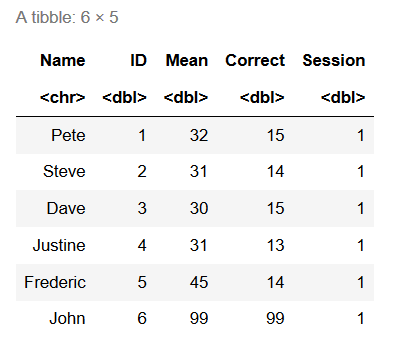
Hither, the read_excel function reads the data from the Excel file into a tibble object. We can if we want to, alter this tibble to a dataframe.
Code language: R ( r )
df <- as.data.frame(df)
At present, later on importing the information from the Excel file you lot tin carry on with data manipulation if needed. It is, for instance, possible to remove a column, by proper name and index, with the R-package dplyr. Furthermore, if you installed tidyverse y'all will have a lot of tools that enable you to do descriptive statistics in R, and create besprinkle plots with ggplot2.
Importing an Excel File to R in Ii Like shooting fish in a barrel Steps:
Time needed:one minute.
Hither'southward a quick answer to the question how do I import Excel data into R?? Importing an Excel file into an R dataframe only requires two steps, given that nosotros know the path, or URL, to the Excel file:
- Load the readxl package
Showtime, you type library(readxl) in due east.g. your R-script
- Import the XLSX file
2d, you can apply read_excel function to load the .xlsx (or .xls) file
Nosotros at present know how to easily load an Excel file in R and tin continue with learning more about the read_excel function.
Reading Specific Columns using read_excel
In this section, nosotros are going to learn how to read specific columns from an Excel file using R. Note, here we will also employ the read.xlsx function from the package xlsx.

- How to use %in% in R: seven Instance Uses of the Operator
- Learn How to Transpose a Dataframe or Matrix in R with the t() Function
Loading Specific Columns using read_excel in R
In this section, we are going to learn how to read certain columns from an Excel sheet using R. Reading only some columns from an Excel sheet may be adept if nosotros, for instance, have large xlsx files and we don't want to read all columns in the Excel file. When using readxl and the read_excel function we volition use the range parameter together with cell_cols.
When using read.xlsx, to import Excel in R, nosotros can utilise the parameter colIndex to select specific columns from the sheet. For example, if want to create a dataframe with the columnsPlayer,Salary, andPosition, we tin can accomplish this past adding 1, iii, and four in a vector:
crave(xlsx) cols <- c(1, ii, 3) df <- read.xlsx('MLBPlayerSalaries.xlsx', sheetName='MLBPlayerSalaries', colIndex=cols) caput(df)
Code language: R ( r ) 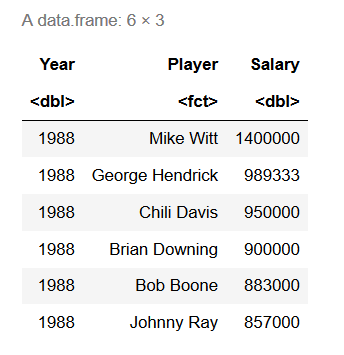
Handling Missing Data when we Import Excel File(s) in R
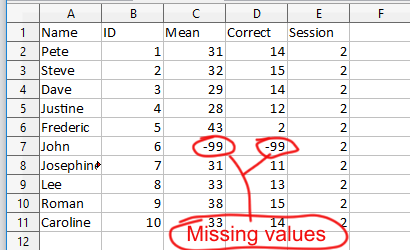
If someone has coded the data and used some kind of value to represent missing values in our dataset, nosotros demand to tell r, and the read_excel function, what these values are. In the next, R read Excel example, we are going to use the na parameter of the read_excel part. Here "-99" is what is codes as missing values.
Read Excel Example with Missing Data
In the example below, we are using the parameter na and we are putting in a grapheme (i.e., "-99"):
df <- read_excel('SimData/example_sheets2.xlsx', 'Session2', na = '-99') head(df, vi)
Lawmaking language: R ( r ) 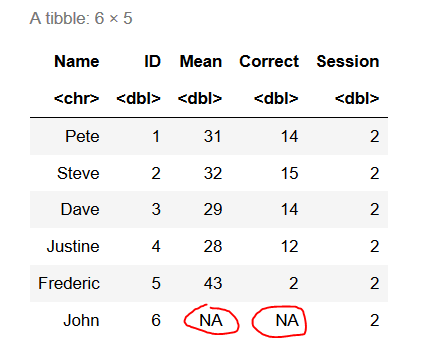
The example datasets we've used in the how to employ R to read Excel files tutorial can be institute here and hither.
How to Skip Rows when Importing an xlsx File in R
In this section, we will learn how to skip rows when loading an Excel file into R. Here's a link to the instance xlsx file.

In the post-obit, read xlsx in R examples nosotros are going to apply both read_excel and read.xlsx to read a specific sheet. Furthermore, we are too going to skip the first ii rows in the Excel file.
Skip Rows using read_excel
Here, we will employ the parameter sheet and put the characters 'Session1' to read the sail named 'Session1'. In a previous instance, nosotros just added the character 'Session2' to read that sheet.
Note, the first sheet will be read if we don't utilise the sheet_name parameter. In this example, the important role is the parameterskiprow=ii. Nosotros use this to skip the first ii rows:
df <- read_excel('SimData/example_sheets.xlsx', sail='Session1', skip = two) head(df, 4)
Code language: R ( r ) 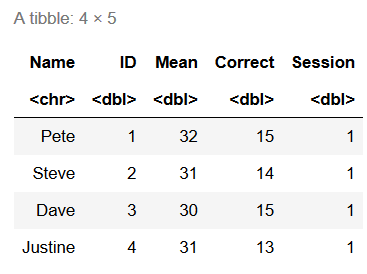
How to Skip Rows when Reading Excel Files in R using read.xlsx
When working with read.xlsx we use the startRow parameter to skip the first 2 rows in the Excel sheet.
df <- read.xlsx('SimData/example_sheets.xlsx', sheetName='Session1', startRow=3)
Code language: HTML, XML ( xml ) Reading Multiple Excel Sheets in R
In this section of the R read excel tutorial, we are going to learn how to read multiple sheets into R dataframes.
There are two sheets: 'Session1', and 'Session2, in the example xlsx file (example_sheets2.xlsx). In this file, each canvass has data from 2 experimental sessions.
We are at present learning how to read multiple sheets using readxl. More than specifically, we are going to read the sheets 'Session1' and 'Session2'. First, we are going to utilise the function excel_sheets to print the sheet names:
xlsx_data <- "SimData/example_sheets.xlsx" excel_sheets(path = xlsx_data)
Code language: R ( r ) 
Now if we want to read all the existing sheets in an Excel certificate nosotros create a variable, called sheet_names.
Afterward we have created this variable we use the lapply function and loop through the list of sheets, use the read_excel function, and cease upwards with the list of dataframes (excel_sheets):
sheet_names <- excel_sheets(path = xlsx_data) excel_sheets <- lapply(sheet_names , office(10) read_excel(path = xlsx_data, sheet = ten)) str(excel_sheets)
Code linguistic communication: R ( r ) 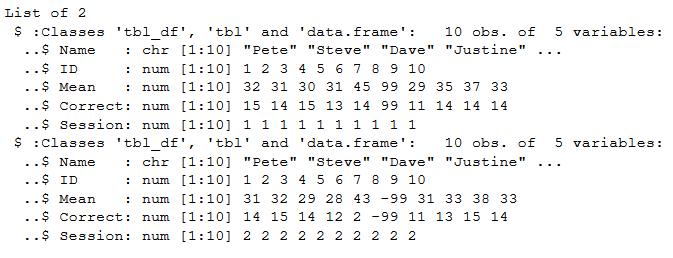
When working with Pandas read_excel west may want to join the data from all sheets (in this case sessions). Merging Pandas dataframes are quite easy. We just apply the concat office and loop over the keys (i.e., sheets):
df <- practice.call("rbind", excel_sheets) head(df)
Code language: R ( r ) 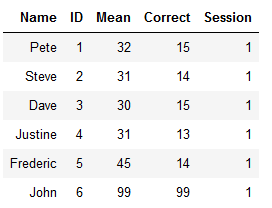
Over again, there might be other tasks that we need to carry out. For case, we can besides create dummy variables in R.
Reading Many Excel Files in R
In this section of the R read excel tutorial, we will acquire how to load many files into an R dataframe.
For example, in some cases, we may have a bunch of Excel files containing data from different experiments or experimental sessions. In the next example, we are going to work with read_excel, once more, together with the lapply function.

Even so, this time we just have a character vector with the file names and then we also employ the paste0 role to paste the subfolder where the files are.
xlsx_files <- c("example_concat.xlsx", "example_concat1.xlsx", "example_concat3.xlsx") dataframes <- lapply(xlsx_files, function(x) read_excel(path = paste0("simData/", x)))
Code linguistic communication: R ( r ) Finally, we apply the do.call function, over again, to demark the dataframes together to one. Annotation, if we want, we tin likewise use, the bind_cols function from the r-package dplyr (part of tidyverse).
df <- exercise.call("rbind", dataframes) tail(df)
Code language: R ( r ) 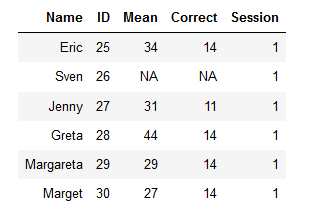
Note, if we want, we tin also use, the bind_cols function from the r-bundle dplyr (part of tidyverse).
Code language: R ( r )
dplyr::bind_rows(dataframes)
Reading all Files in a Directory in R
In this section, we are going to learn how to read all xlsx files in a directory. Knowing this may come up in handy if we store every xlsx file in a folder and don't want to create a grapheme vector, similar above, past hand. In the adjacent example, we are going to use R'due south Sys.glob role to get a grapheme vector of all Excel files.
xlsx_files <- Sys.glob('./simData/*.xlsx')
Code language: R ( r ) 
Afterward we have a character vector with all the file names that nosotros want to import to R, we but utilize lapply and do.call (see previous code chunks).
Setting the Information blazon for information or columns
Nosotros tin can also, if we like, set up the information blazon for the columns. Let'southward use Pandas to read the example_sheets1.xlsx once more. In the Pandas read_excel case below we utilise the dtype parameter to fix the data type of some of the columns.
df <- read_excel('SimData/example_sheets2.xlsx', col_types=c("text", "text", "numeric", "numeric", "text"), sheet='Session1') str(df)
Code linguistic communication: R ( r ) 
Importing Excel Files in RStudio
Before nosotros continue this Excel in R tutorial, nosotros are going to learn how to load xlsx files to R using RStudio. This is quite simple, open up RStudio, click on the Environment tab (right in the IDE), and then Import Dataset. That is, in this section, nosotros will reply the question of how practise I import an Excel file into RStudio?
Now nosotros'll get a dropdown menu and we can choose from dissimilar types of sources. As we are going to piece of work with Excel files nosotros choose "From Excel…":
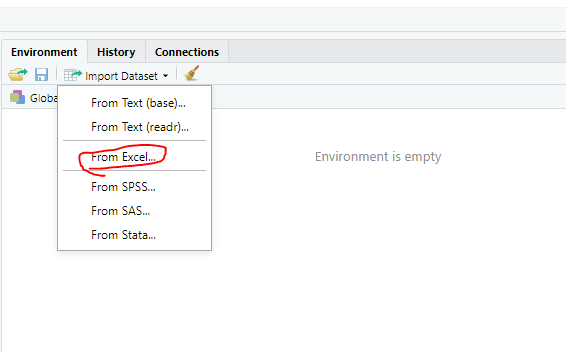
In the next step, we klick "Browse" and go to the binder where our Excel data is located.
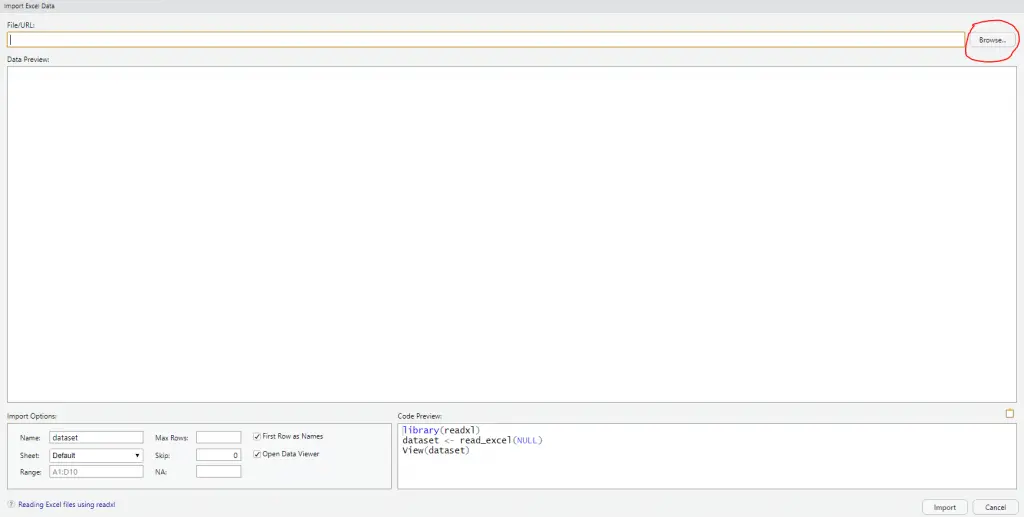
Now nosotros become some alternatives. For case, nosotros tin can change the name of the dataframe to "df", if we want (see paradigm below). Furthermore, before we import the Excel file in RStudio we tin can also specify how the missing values are coded also as rows to skip.
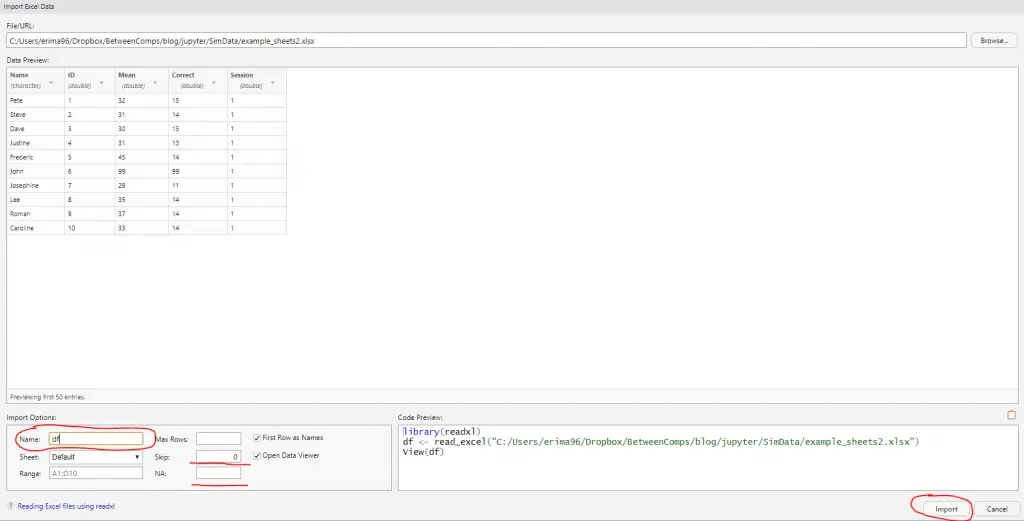
Finally, when we have set everything as we want we can hit the Import button in RStudio to read the datafile.
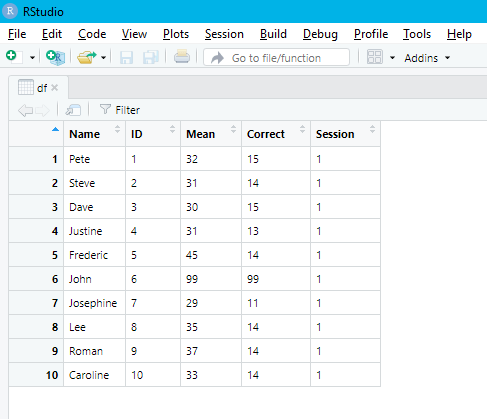
Writing R Dataframes to Excel
Excel files tin can, of form, be created in R. In this department, we will acquire how to write an Excel file using R. As for at present, we have to employ the r-package xlsx to write .xlsx files. More specifically, to write to an Excel file we will apply the write.xlsx function:

Nosotros will get-go by creating a dataframe with some variables.
df <- information.frame("Age" = c(21, 22, 20, 19, 18, 23), "Names" = c("Andreas", "George", "Steve", "Sarah", "Joanna", "Hanna")) str(df)
Lawmaking linguistic communication: R ( r ) 
At present that nosotros take a dataframe to write to xlsx nosotros offset by using the write.xlsx office from the xlsx packet.
library(xlsx) write.xlsx(df, 'names_ages.xlsx', sheetName = "Sheet1"
Lawmaking language: R ( r ) In the output below the issue of not using any parameters is evident. If we don't use the parameter sheetName we get the default canvass proper noun, 'Sheet1'.
As can be noted in the image below, the Excel file has column ('A') containing numbers. These are the alphabetize from the dataframe.
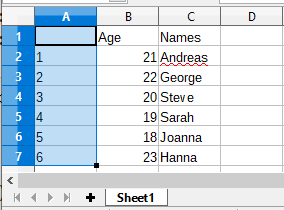
In the next example nosotros are going to give the sheet another name and we will set the row.names parameter to Fake.
write.xlsx(df, 'names_ages.xlsx', sheetName = "Names and Ages", row.names=Imitation)
Code linguistic communication: R ( r ) 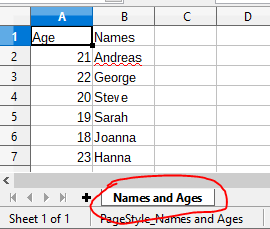
As can be seen, in the image higher up, we get a new sheet name and we don't have the indexes as a column in the Excel sheet. Annotation, if you get the error 'could not find role "write.xlsx"' it may be that yous did not load the xlsx library.
Writing Multiple Pandas Dataframes to an Excel File:
In this section, we are going to learn how to write multiple dataframes to ane Excel file. More than specifically, nosotros will use R and the xlsx package to write many dataframes to multiple sheets in an Excel file.
Offset, nosotros first by creating three dataframes and add them to a list.
df1 <-data.frame('Names' = c('Andreas', 'George', 'Steve', 'Sarah', 'Joanna', 'Hanna'), 'Age' = c(21, 22, 20, 19, 18, 23)) df2 <- data.frame('Names' = c('Pete', 'Jordan', 'Gustaf', 'Sophie', 'Sally', 'Simone'), 'Age' = c(22, 21, 19, 19, 29, 21)) df3 <- information.frame('Names' = c('Ulrich', 'Donald', 'Jon', 'Jessica', 'Elisabeth', 'Diana'), 'Age' = c(21, 21, 20, 19, xix, 22)) dfs <- list(df1, df2, df3)
Code linguistic communication: R ( r ) Next, we are going to create a workbook using the createWorkbook office.
wb <- createWorkbook(type="xlsx")
Lawmaking language: R ( r ) Finally, we are going to write a custom function that we are going to use together with the lapply function, afterwards. In the code chunk beneath,
add_dataframes <- part(i){ df = dfs[i] sheet_name = paste0("Sheet", i) sheet = createSheet(wb, sheet_name) addDataFrame(df, sheet=sheet, row.names=False) }
Code language: R ( r ) It'southward fourth dimension to use the lapply function with our custom R office. On the second row, in the code clamper below, we are writing the workbook to an xlsx file using the saveWorkbook part:
lapply(seq_along(dfs), role(x) multiple_dataframe(x))saveWorkbook(wb, 'multiple_Sheets.xlsx')
Code linguistic communication: R ( r ) Summary: How to Work With Excel Files in R
In this working with Excel in R tutorial we have learned how to:
- Read Excel files and Spreadsheets using read_excel and read.xlsx
- Load Excel files to dataframes:
- Import Excel sheets and skip rows
- Merging many sheets to a dataframe
- Reading many Excel files into one dataframe
- Load Excel files to dataframes:
- Write a dataframe to an Excel file
- Creating many dataframes and writing them to an Excel file with many sheets
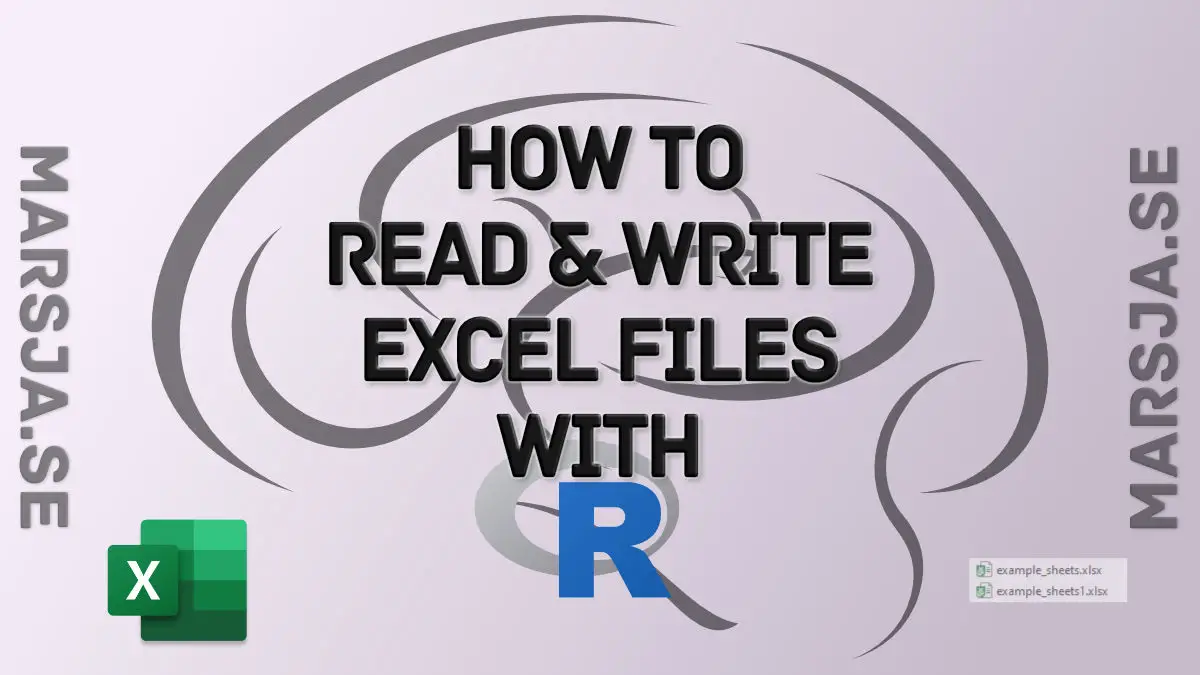
Source: https://www.marsja.se/r-excel-tutorial-how-to-read-and-write-xlsx-files-in-r/


Belum ada Komentar untuk "Read All Sheets Into One Sheet Excel R"
Posting Komentar